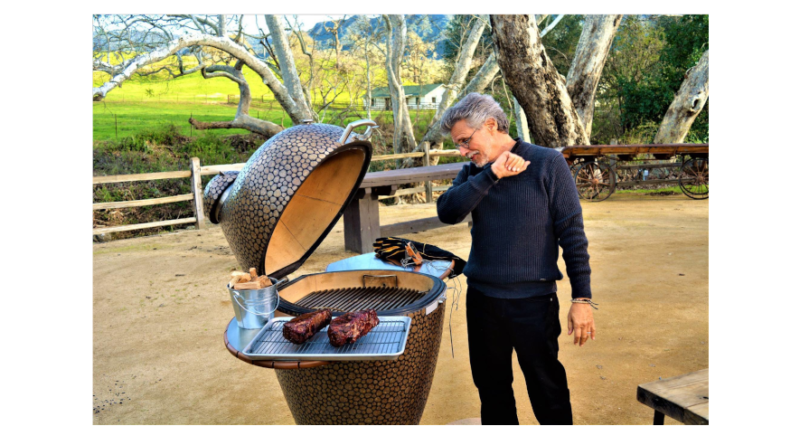From the summer issue of Technology Designer Magazine:
Long before electric pixel arrays served as the primary attraction for our nighttime gaze, our eyes were usually lost in the sprite sparks and mesmeric embers of a fire in the dark. Since the beginning, people have gathered around a crackling burn to create art and cookware, stay safe and warm, sing songs and dance and prepare critical sustenance to survive. This summer, temperatures soared again, transforming our screens into startling images of catastrophic flames. As the infernos and clouds of smoke cascaded across the map, I felt the need to ask: given that we are inevitably going to prepare food, what are the environmental cost differences between cooking indoors versus outdoors – and how can I optimize my cooking footprint amidst this towering heat we are learning to live with?
Depending on your kitchen, cooking inside can be hot and taxing in the summer, hence the liberating feeling that comes with searing your favorite foods outside in the cool evening air. Similarly, in the United States, cooking appliances are subject to virtually non-existent residential indoor air quality regulations and require extra cooling during warmer months. Once outside, however, you are suddenly part of the commons, sharing airspace with not just your community, but the biosphere at large. Just as we take responsibility for what enters our water system, we now have to consider more closely what we add to the atmosphere, especially as we ride out remaining ripples of a respiratory pandemic.

Solar ovens aside, the commonly accepted wisdom for average consumers looking to cook outside while minimizing their carbon footprint is to use propane or natural gas. During use, your standard propane grill or natural gas powered cooking station burns cleaner than lump charcoal or briquettes, emitting roughly half as much carbon dioxide (CO2). This seems straightforward enough, but recent data also indicates that the CO2 emissions savings of natural gas and propane do not take into account the considerable amount of unintentional methane leakage that occurs in the search, excavation and production of the fuel. In the short term, methane is a far more potent greenhouse gas than CO2, bringing an estimated 80x the warming power over the first 20 years after it reaches the atmosphere. Given the immediacy of the situation we face, we could do ourselves a huge favor by finding every possible way to cut out excess methane release, which starts with lessening our reliance on (or at least cleaning up) fossil fuel extraction and production.
So then I wondered, if I decide to indulge in our ancestral past and prepare my food over burning coals, what’s the most sustainable, effective and enjoyable way to do it? Given all the progress that has occurred in the 20,000 plus years humans have been using this material – where exactly does the technology stand today?
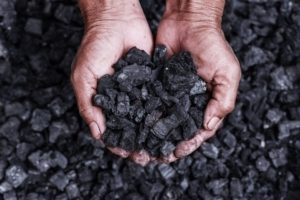
First, let’s start with the material itself. Charcoal is typically hardwood that has been deprived of moisture and oxygen using incredibly high levels of heat, generally via a large kiln. The result is nearly pure carbon. Trees, of course, are a wonderful store of carbon – as they sequester CO2 from the air, separating the carbon and oxygen molecules during photosynthesis. So as you might imagine, logging trees to produce charcoal sounds antithetical to solving any type of climate crisis – and you’re right. Luckily, at least in the United States, charcoal manufacturers can only source excess or scrap wood from existing timber or sawmill operations, and the emissions created through the firing process are strictly regulated by the Environmental Protection Agency (EPA).
When shopping for charcoal with your footprint in mind, it’s good to avoid products that either include or require additional petroleum products such as lighter fluid, as well as generate large amounts of ash due to additives. Charcoal briquettes that are designed to light and burn quickly tend to fall into this category, while most raw lump charcoal contains no additives, and can be snuffed out after cooking and reused after the remaining ash is removed. Things get a little trickier once you head further south (where there is often less regulation on deforestation), but also very attractive products, like the varieties of hardwood that are used in high-end Brazilian steakhouses. Additionally, there are formidable new charcoal alternatives developed from reasonably renewable materials like extruded coconut shells, eucalyptus trees and even discarded coffee trees.
Now, let’s take a look at the various vessels to maximize charcoal’s effectiveness. The three main categories are ceramic, metal and refractory cement. Ceramic grills have slowly carved out a niche for themselves in the post WWII era. Highly popular ‘kamado-style’ grills like the Big Green Egg, Primo and Kamado Joe were originally inspired by various earthenware cooking technology known as mushikamado found in southern Japan both during and after the war, and have since evolved over time to combine elements of both the ancient East and modern West. The egg shape design still allows for a large cooking surface area that can be scaffolded with various risers and grates, while also maximizing heat and moisture retention through the ceramic composition.
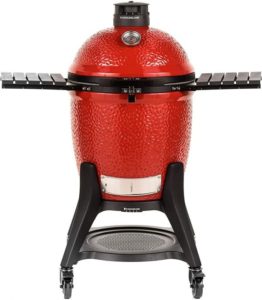
Kamado grills are ideal for slow, low smokes, but most can safely withstand high temperatures over 700ºF for seared steaks or thin crust pizzas. Each brand has its own line of accessories that modify its functionality, such as a ceramic convector plate to transform the grill into an oven or cast iron plate. On the more modern side of things, many models can be temperature controlled from a web browser or mobile device through an additional Wi-Fi control kit that adjusts the air intake with a networked cooling fan that responds to temperature sensors inside the grill or your food. Stick a little temperature sensor into your favorite grilled delight and monitor it remotely. What would our ancestors think?
As far as metal grills go, there’s few that go above and beyond in terms of efficiency when using charcoal as fuel. Metal grills dissipate more heat through their surface and body, causing it to be continually replaced by drawing more air into the unit and thus burning fuel faster. Metal grills also tend to have a shorter lifespan than ceramic or refractory materials, largely due to their capacity to rust. Ultimately, this means more frequent replacement and more landfill waste (another major culprit in methane release). However, given the price point they are still a solid starting option for many.
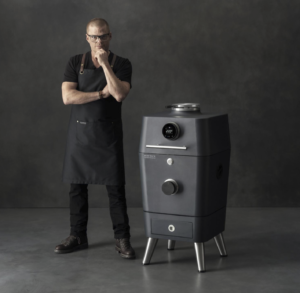
Those inclined to spend more on a metal charcoal system should at least have a look at the Everdure 4K. Designed in partnership with acclaimed British chef Heston Blumenthal, the 4K is a diecast aluminum charcoal grill that looks a bit like something from the Jetsons, but luckily wields the futuristic tech to back it up. It’s by far the ‘smartest’ grill out-of-the-box, sporting a Nest-like central touch control panel, which connects via Bluetooth to a custom mobile app for temperature monitoring. It also features rapid one-touch charcoal ignition, auto-locking hood, and some elegantly engineered airflow controls, reminiscent of a large rotary dial of a lock safe. The jury is still out on the 4K as a viable long-term option, but it’s no doubt a glimpse of what a fully integrated system might look like in the future.
Last, but certainly not least is the refractory cement vessel. Refractory materials are engineered to be resistant to decomposition by heat, pressure or even chemical attack. They retain strength and form at high temperatures and are most notably used in furnaces, kilns, incinerators and reactors. Variations in formula are also found in high temperature pizza ovens. Certain contractors and builders with oven and grill knowledge may also be able to fashion a custom system for you from scratch. However, if you’d rather just purchase a one-of-a-kind refractory Kamado style grill, there’s really only one place to go: Bali. Just kidding, you don’t have to go to Bali (though maybe you should). Rather, just search Komodo Kamado and you’ll quickly find the brilliant beasts I am speaking of.
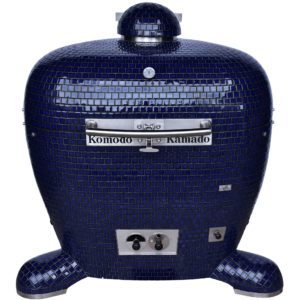
As a kid, I was as fascinated as I was fearful of Komodo dragons and this grill elicits a strangely similar feeling. Featuring a cast refractory cement body, combined with laser CNC cut 304 stainless steel components, the Komodo Kamado is essentially a charcoal furnace draped in beautifully glazed artisan tiles that pay tribute to the shimmering scales of Bali’s native reptilian kings. These hybrid oven/grills come in seven different sizes, ranging from the small 16” diameter tabletop ‘Brawny Bambino’ to the 42” industrial kitchen masterpiece known as ‘Serious Big Bad’. The smallest standing model’s net weight comes in at just over 550 lbs, held up by four dragon-like feet with casters built in.
Award-winning author and TV host Steven Raichlen calls the Komodo Kamado “unbelievable”, after completing an 85 hour cook with heat control to a single degree. This level of retention is unmatched and speaks volumes about what is possible with charcoal when the right design and materials are employed. Unfortunately, you won’t find one in any retail stores, but the company offers anyone interested a direct line to their Founder to discuss purchasing. If seriously interested, make a reservation in advance, especially if selecting custom tile options. And consider including some extruded coconut shell and coffee tree charcoal with your shipment.
As another summer of fun and flames winds down, let’s all take stock of the costs required to refuel ourselves. How and what we choose to eat not only influences our personal wellness, but that of the planet too. While the largest climate offenders ultimately need to be held accountable, the taste of cleared forests for flank steak or mismanaged methane for propane is quickly becoming too common of a flavor in our palette. Our continued support for products and practices that are ultimately endangering our livelihood is not something history, or our descendants, will look kindly upon. If anything, these distressful scenes should inspire us to change course in order to keep some of our most beloved traditions and pass along to the next generations.

